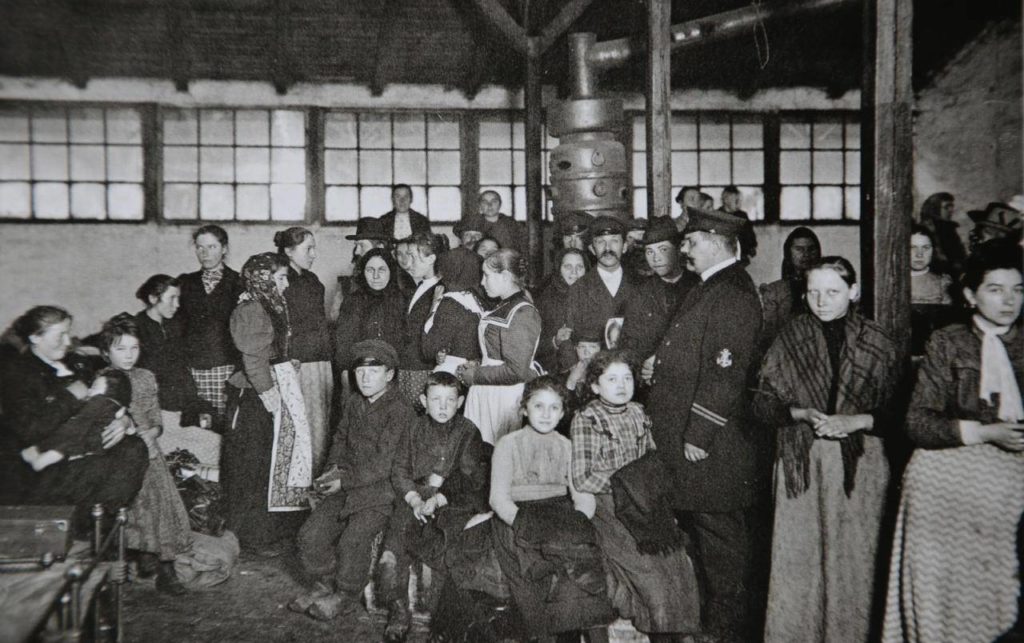The train from Berlin deposited its passengers — including Brunis Paul, her three-year old daughter Helen, and their traveling companion Bertha Henkelmann — at the Berliner Bahnhof in central Hamburg. Holding tickets for a Hamburg America Line (Hamburg-Amerikanische Packetfahrt-Aktien-Gesellschaft, or HAPAG) ship to the United States, the three weary migrants and their baggage were transported by a great horse-drawn wagon to the America Quay. There HAPAG operated a barracks complex of ten long buildings that could hold up to 1400 migrants at once. Built in 1891, this housing complex was completely sealed off from the outside world. Here migrants would wait in a little village all their own for their ships to sail, just as the German government and the residents of Hamburg wanted it.
Conditions in the barracks were better than in the rooming houses of the Alley Quarters, but still left much to be desired. Overcrowding was always a problem. Eleven-year old Mary Antin, a Jewish girl from Poland traveling through Hamburg a year earlier, said of her barrack,
It looked something like a hospital, only less clean and comfortable; more like the soldiers’ barracks I had seen. I saw a very large room, around whose walls were ranged rows of high iron double bedsteads, with coarse sacks stuffed with something like matting, and not over-clean blankets for the only bedding, except where people used their own. There were three windows almost touching the roof, with nails covering all the framework. From the ceiling hung two round gas lamps, and almost under them stood a little wooden table and a settee. The floor was of stone. Here was a pleasant prospect. We had no idea how long this unattractive place might be our home.
Brunis and the girls may have whiled away several days here waiting for their ship to arrive in port. That ship was the Markomannia, built in the Howden shipyard in England in 1890. It was originally christened the Benwell Tower but renamed upon its sale to the Hamburg America Line. At 333 feet long and 3335 GRT, the Markomannia was just half the length and around one-quarter the tonnage of the largest ship in the world of the time. It was also slightly smaller than the Wisconsin that carried Julius Paul to America three years earlier. Yet despite their similar sizes, the Markomannia carried a mere 80 passengers while the Wisconsin carried near one thousand. Why? Because the Hamburg America Line used the Markomannia to serve double duty as both a passenger and a cargo ship. In fact, at a mere 80 passengers — all of them strictly steerage class — transporting cargo was its primary purpose.
Brunis, Helen and Bertha departed Hamburg on June 25, 1895. The small size and the single screw of the Markomannia meant for a slow journey to America. They didn’t arrive in Philadelphia until July 13 — a voyage of 18 days. The world’s fastest steamship at the time, the Lucania, could make the crossing in under 6 days, so clearly speed was not of the essence for a trudging cargo ship like the Markomannia. We can only imagine how the passengers whiled away the many days at sea, talking, singing, sleeping, walking the deck, battling sea-sickness. About half the passengers were from parts of the Russian Empire and most of the rest from German-speaking lands in Central Europe, so Brunis and the girls must have had plenty of familiar company. The most exciting event of the trip surely was the birth of a baby girl to the Osiensky family from Płock, Poland. Parents Jacob and Mary named their newborn daughter Oceana Josefa in honor of her birth at sea.
SOURCES
Mary Antin, From Plotzk to Boston. W.B. Clarke & Co., 1899.
Jörg Berlin and Matthias Schmoock, Auswandererhafen Hamburg Emigration Port. Hamburg: Medien-Verlag Schubert, 2000.
Tobias Brinkmann, “‘Travelling with Ballin’: The impact of American immigration policies on Jewish transmigration within Central Europe, 1880-1914.” International Review of Social History 53 (2008).
Hapag-Lloyd, “125 Years Ago: Hapag Opened its Emigrant Accommodations on the America Quay.”
“MARKOMANNIA launched as BENWELL TOWER,” Tyne Built Ships.
Janet I. Wasserman, “The journey from Eastern Europe to North America in 1900 & 1904” (2012).

